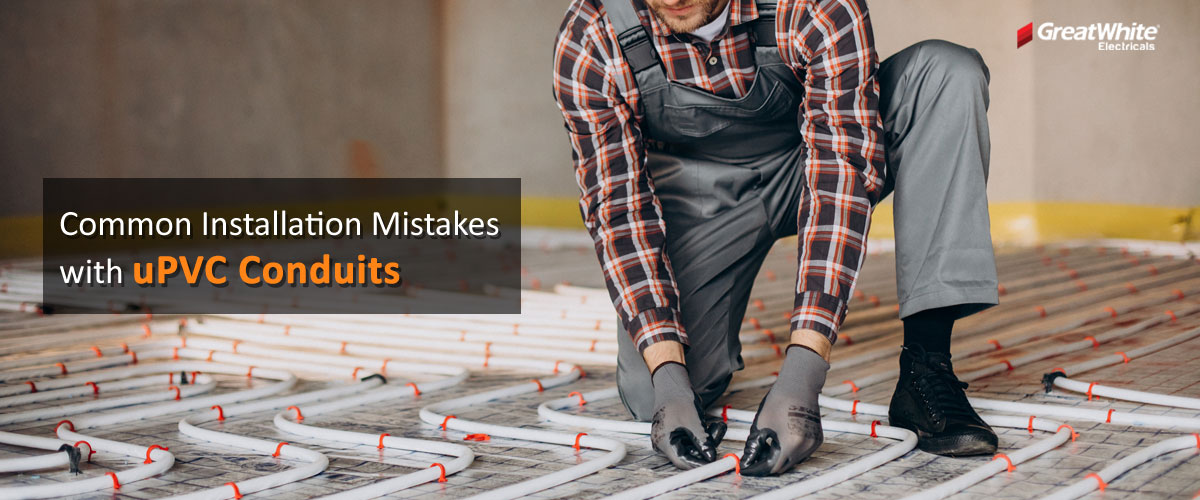When it comes to electrical wiring, uPVC conduits are a popular choice for homeowners. Durable, lightweight and affordable, uPVC Conduit systems are possibly the most commonly employed form of Cable Management.
Well designed and executed uPVC conduit installations offer below key benefits:
- Safety: uPVC conduits protect wiring from damage, moisture, rodents and pests.
- Maintainability, Flexibility and Futureproofing: It is easier to upgrade, repair or replace wires running through conduits, including adding or modifying circuits if necessary at a later date in the system without tearing into walls or ceilings.
- Cost: Well planned conduit layouts helps reduce the overall wiring costs on immediate basis and provide savings on maintenance costs and costs of changes/upgrades over the long term.
However, if not installed properly, they can lead to frustrating repairs, electrical failures or even safety hazards. Whether you're overseeing an installation or doing it yourself, here are the most common mistakes to watch out for—and how to avoid them.
1. Skipping the Planning Stage
Think of uPVC conduit installation like putting together a puzzle—except if a piece is missing, it’s your home's electrical system at stake!
Many homeowners rush into installation without a clear plan, assuming they can make adjustments later. Unfortunately, poor planning leads to:
- Conduit upvc that are too short or undersized —forcing you to redo sections
- Hard-to-reach areas—making future maintenance difficult
- Unnecessary bends or joints—causing weak spots in the system
- Higher cost of maintenance or upgrades in the long term
Solution: Before installation, sketch out your layout and measure conduits precisely. Keep future access in mind, so repairs and upgrades don’t turn into a nightmare.
2. Using Incorrect Fasteners Just like good furniture needs sturdy screws, uPVC conduits need the right fasteners to stay secure. Using weak or incompatible fasteners can result in:
- Loose conduits, increasing the risk of wire exposure
- Cracked plastic, leading to moisture and dirt ingress causing electrical failures
3. Not Accounting for Expansion & Contraction
uPVC expands and contracts with temperature changes. If conduits are installed too tightly, they warp, crack or pull away over time—especially in outdoor or attic installations.
Solution: Leave small expansion gaps at key joints, especially in long conduit runs. This prevents strain on the system and maintains its integrity over the years.
4. Improper Cutting of Conduits Cutting uPVC conduits might seem simple, but many installers use the wrong tools, leading to:
- Jagged edges that damage wires over time
- Uneven cuts, causing gaps in connections
5. Skipping Sealing
Imagine a house without a roof—it’s exposed to dust, water and pests! Similarly, unsealed conduit joints can allow moisture or debris to seep in, damaging electrical wiring.
Solution: Always seal conduit joints properly, especially in outdoor areas or spaces prone to humidity, like basements. Weather-resistant sealants help ensure a tight, long-lasting installation.
6. Overloading the Conduit
More wires ≠ better performance! Many homeowners try to fit too many wires into one uPVC conduit, causing:
- Overheating and increased fire risk
- Difficulty pulling wires through tight spaces
- Reduced electrical efficiency
- Making future repairs or upgrades difficult
Solution: Follow manufacturer guidelines on the maximum wire capacity. If needed, install additional conduits rather than forcing too many cables into a single run.
7. Ignoring Safety Standards
Electrical codes and safety regulations exist for a reason! Ignoring these can lead to non-compliant installations, making insurance claims difficult or even risking electrical hazards.
Solution: Always check local building codes before installation. Hire a licensed electrician if you're unsure—it's better to be safe than sorry.
Final Thoughts
Making sure your uPVC conduits are installed correctly will save you money, frustration and potential electrical issues down the road. By avoiding these common mistakes, you’ll ensure long-lasting protection for your electrical wiring while maintaining safety and efficiency. Thinking about installing uPVC conduits in your home? Got a question or a tip of your own? Drop a comment—we’d love to hear from you!

